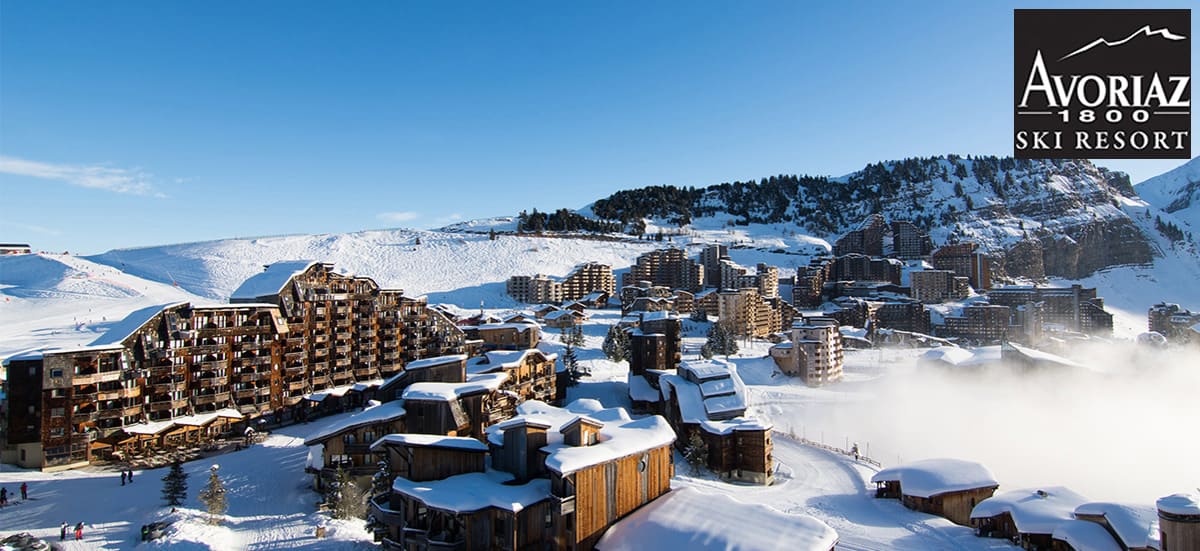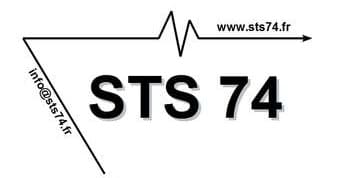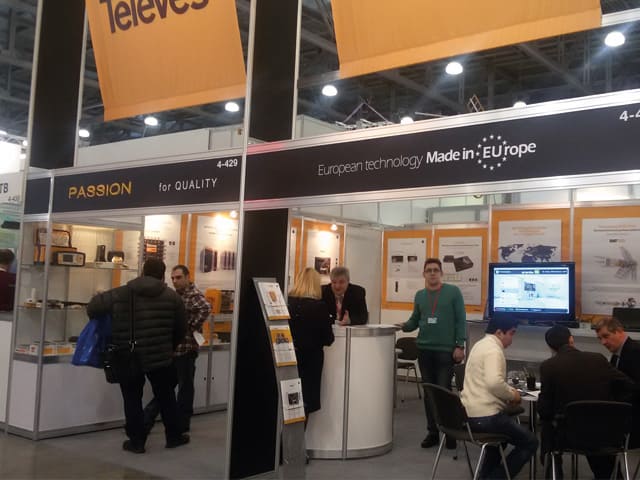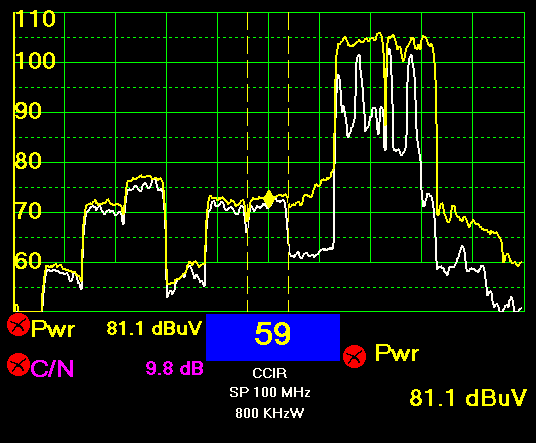Documentation
Complete and updated service and product documentation available for viewing and download. Select a category to begin your search.
InfoTeleves 34 (February)
- General Information: QSD85: Excellence under the strictest criteria
- Televes in the world: SENA Training and CSTB Telecom & Media Exhibition and Forum and Arab Health Exhibition
- Always up-to-date: Firmware update to v2.00 for H60 and H45
- FAQs: Is it necessary to use F connectors with O-ring?
- Your pictures: Motorized antenna
- Technological trens: DTT accelerates its evolution in Europe with DVB-T
- Training: Adapting installations against LTE/4G signals
- Did you know...: ... 30 years ago Televés presented a prototype of a flat antenna?
- Ideas: How to configure the CoaxData Gateway as a Master
- Facilities: Avoriaz Ski resort (Haute Savoie - France)
- Announcement: Coaxdata
General Information
QSD85: Excellence under the strictest criteria

Excellence is a goal that is never really achieved, it is a philosophy that takes each day as a process of continuous improvement. It is therefore particularly pleasing when an industry benchmark uses the word excellent to describe the results of your effort.
The prestigious German magazine Digital Fersenhen has given Televes QSD85 the highest rating in a report titled "Spanish Quality", which presents the results of a comprehensive analysis of satellite dishes in the competitive German market. QSD85 is highlighted for ease of installation, long-term quality and signal reception levels, with C/N values between 14.3 and 15.6 dB. In summary, QSD85 is at the same level of performance as the first German manufacturer of reference, but with the advantage of a much more competitive price..
QSD s the premium line of Televes dishes. Approved by the TÜV institute, they are characterized by using advanced CAD design, leading to accuracy in signal reception, as well as durability. These aluminum dishes deploy a sturdy Zamak support for fixing the LNBs, with hidden wiring for a professional look to the installation. They feature stainless steel hardware and mounting brackets which also undergo a process of hot dip galvanization to grant higher resistance to corrosion. Another strength of the range lies in the ease of assembly on-site, which takes place in four simple steps. The support arm and the LNB, which is adjustable in height, are preassembled from factory.
This is not the first accolade received by the QSD in Germany. Last year, experts from another highly regarded magazine in the industry, Satellit Empfang + Technik, also highlighted the quality of signal reception and ease of installation of the product, giving a score of 88 out of 100, placing it above the other two leading manufacturers compared.

Televes in the world
SENA Training and CSTB Telecom & Media Exhibition and Forum and Arab Health Exhibition
SENA Training Bogota and Bucaramanga (Colombia) December 2015 - January 2016
Televes has signed a collaboration agreement with the National Learning Service of Colombia (SENA) to provide courses on reception and distribution of digital terrestrial television signals (DVB-T / DVB-T2), satellite TV and integral solutions for cable operators.
CSTB Telecom & Media Exhibition and Forum (Moscow) 26-28 January
In this edition, held in the Crocus Exhibition Center, Televes witnessed the explosion of integral IP distribution solutions, as well as the growing interest in 4K content. Televes had the change to share its expertise in network infrastructures for high capacity data and for distribution of new generation television services.
Arab Health Exhibition (Dubai) 25-28 January
The event was held at the International Convention and Exhibition Centre, bringing together vanguard providers of advanced medical services. Televes presented Carelife technological solutions, for the care and safety of senior people who enjoy the freedom of independent living.
Always up-to-date
Firmware update to v2.00 for H60 and H45
The new firmware version implements significant improvements in already installed features and offer adaptations to multiple markets:
- Improvement on the speed obtaining measures over ethernet.
- Improved hitch on DVB-S2 after memory recovering with SR Auto (Polish versions only).
- Hardware compatibility with new versions.
- LTE filter graphs for ELECNOR added.
- Improvements in the measures on the website of GPS Tracking.
- Graphic option in H45 Compact (59902x) (Australia only).
- Added Turkish language.
- FM deviation measure.
- FM RDS measure for Turkey.
- QAM AnnexB option for Latin America.
FAQs
Is it necessary to use F connectors with O-ring?
The O-ring is a component that protects the installation from moisture.The expert says
Almost always, the expression "save a penny, spend a dollar" is really true.
The inclusion of an O-ring in the F connectors prevents the risk of "flooding" of the connection. The effects can be quite disastrous and can range from degradation of the frequency response of the network to expensive breakdowns in remotely powered elements.
For this reason, and in at least outdoor cable runs, it is very convenient to always use connectors with O-ring. In indoor facilities, although the risk of water entering in the network is smaller, the O-ring can prevent the undesirable effects of condensation.

Photo of the F connector F where the O-ring is visible.
Your pictures
Motorized antenna
If you were to travel to Mora (Toledo), you could still see, although out of service, an old motorized antenna. The curious thing about the picture is that, to avoid the obstacles which prevent the reception of all satellites in the "Clarke Belt," the antenna needed to be lifted.
The oldest installers might remember the difficulty of adjusting this type of satellite dishes, but if that adjusting porcess was to be carried on the top of a turret, the merit is even bigger. Is that so, that they don't even contemplate the possibility of disassemble it.
Technological trens
DTT accelerates its evolution in Europe with DVB-T
Germany has designed an ambitious timetable for the implementation of the second generation standard, with the focus places on ultra high definition and on-the-move receptionDespite the growing strength of other platforms, it is undeniable that Digital Terrestrial Television is still the preferred choice in Europe to enjoy audiovisual content. Far from signifying its decline, the phenomenon of the so-called second screen goes to show the perfect balance between DTT and Internet TV, now enhanced by 4G / LTE networks.
Most European countries are aware of the crucial role DTT plays as a means for universal, low-cost access to information, entertainment and culture. It is clear, moreover, that its future lies in the evolution to DVB-T2, advanced standard that is already a reality in Russia, Italy and Britain and is in advanced stage of tests in countries like France. In this context, Germany's decision to accelerate the adoption of DVB-T2 technology can have a big impact. The Berlin government has already drawn up a timetable that foresees the first pilot tests within 2016. The full process is expected for completion in 2019.
The race to DVB-T2 in Germany means that the second digital dividend, that is the release of the 700 MHz band, also be advanced. As for users, the changing technology means they will need to purchase new receivers compatible with the technical requirements already defined.
One reason for this strategy is the commitment to HD. In this sense, Germany deploys HEVC encoding in conjunction with DVBT2, allowing the German DTT to compete in HD content with satellite and IPTV plaftorms, with the benefit of lower transmission costs. But perhaps most important is that this combination of technologies opens the door to the distribution of programs in ultra high definition (UHD). This would propel DTT into a new dimension in television, since UHD brings picture quality 16 times greater than current HD.
Another issue that Germany considers of great importance for migrating to DVB-T2 is on-the-move reception. With the second generation of DTT standard, that possibility becomes a reality.

Digital Terrestrial Television Systems. Blue indicates countries that have adopted or deployed DVB-T and DVB-T2. August 2015
Copyright 2013 DVB Project. DVB and the DVB logo marks are registered trademarks of the DVB Project.
Training
Adapting installations against LTE/4G signals
Most of the incidents related to LTE/4G are caused by a low level of DTT receptionIn the areas affected by the LTE/4G signals there is a risk of interference with DTT channels. Most of the incidents occur in areas where DTT is propagated with difficulty and with CBER and MER values even below the desired minimum. In these situations, any variation on the condition of the spectrum (as the appearance of unbalanced signals, affecting active devices) increases the risk of degradation of the television signal.
In this situation, the installer can choose between several solutions to find the one that best suits the reception conditions.
The most obvious option is to install a filter. There are different selection criteria to choose between the different filters of Televes, where signal rejection is often seen as the main one. But when choosing the filter we also need to consider carefully the value of insertion losses, as it can be critical in situations like the one described. This is the reason why Televés, when designing filters, pays special attention the insertion loss in the highest channel.
If the signal recieved is too low, the filter is used to prevent the signal to be degraded as it passes through the amplifier, though it will not help to improve the reception conditions. In this situation is more suited to use an active element that is as immune as possible to the LTE band, wich allows to improve the MER of the signal coming from the antenna. That element is the QBOSS, integrated (or not) in the antenna DAT HD 790.
The combination of a DAT HD 790 together with a filter with DC pass can be considered as the complete solution, especially in installations where the amplifier is set at maximum gain.
Therefore, experience shows that certain actions can be carried out to increase the distance to the "digital cliff." Which one to choose will depend on the type of installation, frequencies of the signal and the level difference between DTT and LTE/4G signals.
What looks to be clear is that the three possible actions to take, one of them or in possible combinations, are: Installation of filters with high rejection and low pass-band attenuation. Using DAT HD 790 antenna in active or passive mode.Activate the QBOSS.

DAT HD BOSS 790

Q-BOSS

Microcavities filter
Did you know...
... 30 years ago Televés presented a prototype of a flat antenna?

It was in the Sonimag-86 exhibition in Barcelona. This antenna, which design was based on Fresnel rings, was obviously relegated to laboratory prototype.In three decades, the evolution of TVSAT reception has resulted in devices ranging from electronic flat antennas to the the current optical LNB, or the transition from analogue modulation to the present and sophisticated digital modulations.
This comes to show 30 years of television history reflected into the history of Televés.
Ideas
How to configure the CoaxData Gateway as a Master

The typical configuration of a CoaxData network has a master, in the 7692 range, and several slaves, also in the 7692 range or ref.76930 CoaxData Gateway.
But if the desired functionality is that the master itself works as a router with full functionality, including the network connectivity via WiFi, the solution is to configure a CoaxData Gateway ref.769301 as a master.
To do this, the internal architecture of the device must be configured using a configuration file available on Televés website:
http://www.televes.com/en/node/26934
Once loaded the configuration, this new master will have the following characteristics:
- WAN input associated with a DHCP client for connection to a main router (operator router) through the LAN/WAN ethernet port.
- LAN outputs associated with a DHCP server: LAN1, LAN2, Coaxial port eth0 and WiFi ath0.
- Functionality as a master that extends the LAN through the coaxial network and through the ethernet network (UTP / FTP).
- It has a configuration interface through a VAP, that allows access to the configuration options regardless the possible changes of the internal configuration of the router.
Facilities
Avoriaz Ski resort (Haute Savoie - France)

The ALDA resort, in the Avoriaz ski resort, is migrating it's DOCSIS installation to optical fiber, using GPON protocol. The resort includes 3,500 apartments, where the deployed services are high-speed Internet and HDTV via RF Overlay. In addition, it was deployed a maintenance service network using virtual wireless networks.
The equipment from Televes included one OLT 510 ref.769401, one YEDFA ref.234228 and a T.0X optical emitter ref.234305.
In each apartment migrated to the new network it was installed an ONT Home ref.769502.

INSTALLER:

Announcement
Coaxdata











